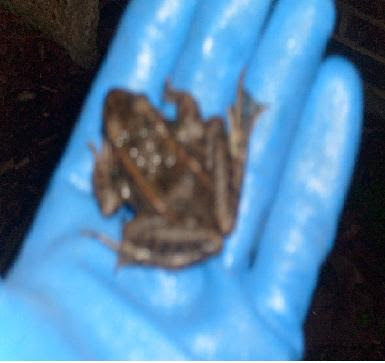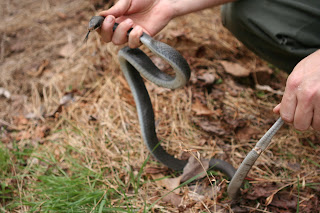
Earlier today, our herp class went on a trip to the Quarry at Hueston Woods, which is about ten minutes outside Oxford, OH. What started out as a cold rainy day eventually warmed up, which led us to find a bunch of different species around a river. While searching among the stones and logs off the shore of the river I uncovered this longtail salamander (Eurycea longicauda). When I first lifted the rock he was resting under, I thought it was a southern two lined salamander, since they are about as common as mud around here. However, when I picked him up, I noticed the characteristic spotting pattern and realized it was the longtail. He was about 4 1/2 inches long with a brown/orange base color and black spotting pattern.
The longtail salamander is typically found along streams, where they tend to hide among rocks and logs. They are identified by their long tails and characteristic spotting pattern. They lay their eggs amongst rocks and around caves, and the larvae usually take about 1 year to fully metamorphose.
(Matt O'Toole, Miami University)


















.JPG)
.JPG)

















 Female
Female Also a species to note that we observed earlier that day around 1:00, still in Oxford but along the wide 4 mile creek (more north east of where we these animals were found) was a Spiny soft shell turtle (Apalone spinifera). We caught a glance of him basking on a wide log that protruded into the middle of the stream. It was pretty far away, so idenifying him by the traditional nostral ridges, streaked foot pattern, or rough shell was impossible. Due to our location, it is more probable to find the Spiny softshell rather than the Smooth softshell. These animals are highly aquatic and prefer large bodies of water where they can bask on logs or hide in mud flatts.
Also a species to note that we observed earlier that day around 1:00, still in Oxford but along the wide 4 mile creek (more north east of where we these animals were found) was a Spiny soft shell turtle (Apalone spinifera). We caught a glance of him basking on a wide log that protruded into the middle of the stream. It was pretty far away, so idenifying him by the traditional nostral ridges, streaked foot pattern, or rough shell was impossible. Due to our location, it is more probable to find the Spiny softshell rather than the Smooth softshell. These animals are highly aquatic and prefer large bodies of water where they can bask on logs or hide in mud flatts.





















